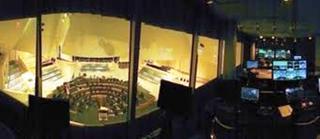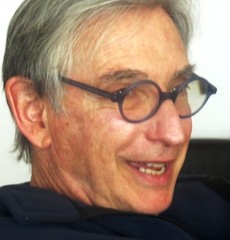|
Back
30 Years of New World Symphony (III)
05/25/2018
(This is the third piece on the 30th anniversary of the New World Symphony)

Auditorium from the control booth
Claudio Monteverdi, Hector Berlioz and this writer have one thing in common: The words “fiber optic” were alien to us all. No doubt the Italian and French masters would have mastered the concept and used it. And at the end of three days in the New World Symphony Frank Gehry-built building in Miami Beach, even this non-tecchie began to see how that phrase has transformed the Academy, America and the musical world.
The young musicians, who, several decades ago would have practiced and practiced in order to meet their teachers once a week or rehearse when space was available, here have the benefits of being able to communicate with their peers and a whole slew of mentors, miles and even continents away. The fiber optics and technical legerdemain which I could never hope to really understand, has a goal which is simple and effective.
In a single word: communication.
Justin Trieger, the academy’s Director of New Media, speaks about New World Symphony’s use of Internet 2, as well as the anagramed LOLA.
“LOLA,” he explains, “is low latency. Internet2 is more than a mere broadband network, it has a connection more than one-hundred times faster than standard commercial internet.
“And LOLA means that we can broadcast–and be broadcasted to over 1,000 miles with a delay of...oh, maybe 40 milliseconds.”
Even that tiny delay (as well as inevitable minor glitches) means that a conductor like Michael Tilson Thomas could not lead an orchestra in another city. (Nor is Internet 2 without its deficiencies at time). But for all practical purposes in the cyber-world, it allows the incredible Master Class described in yesterday’s column.
Augmenting that is MUSAIC, a digital video archive program. So far ten conservatories in the United States and Europe can share archives of performances, rehearsals, talks, seminars, and just about everthing which goes on.
Example? The town of Chattanooga, Tennessee, not exactly the cynosure (though perhaps the Tennessee-born Dinah Shore) of music. When I was there, two Chattanoogans–a techie and a librarian–gave the most enthusiastic talk on their connection with New World Symphony.
It took many hours of education, elucidation and convincing to get the City Fathers and Mothers to learn about LOLA and MUSAIC, Yet somehow, they were convinced that an investment here might do good.
Today, the library exec explained, “it’s the coolest library in the country.” The reason is that they can. The original reason was that it facilitated recording studios. (And a traditional Southern town has dozens of young players to be heard.)
The second reason was to teach young people how to engineer and produce music, again putting together creativity and technical facility.
But now comes the New World Symphony aspect. Thanks to LOLA technology, Chattanooga can not only communicate with musicians around the world, they can actually perform with the professional-level musicians of the New World Symphony.
And perform under the baton of Michael Tilson Thomas, one of the great international conductors.
Back behind the auditorium, I was introduced to Clyde Scott, NSW’s Director of video projection and resident projection designer – as well as his studio packed with the latest control boards, monitors and futuristic gimmicks. Much of it has been donated by the manufacturers, though that isn’t quite pro bono. They want to experiment with their instruments, Mr. Scott, both musician and video engineer, is the one to do it.
“Michael,” he says, speaking of MTT, “would only allow us to experiment with works that have no history, modern pieces where video installations would allow viewers to get another idea of the piece.” As an example, he broadcast on the screen part of Philip Glass’s Fourth String Quartet. The dancers were “enhanced” with slow languorous motion, with the most varied lighting. Also under his supervision are 10 robotic cameras which are pre-set to record various soloists, consorts and the complete ensemble when a concert is shown to the viewers outside, in the free 2.5 acre park where they picnic, drink and get an original satisfaction.”
As to the latter, the New World Symphony attracts big crowds to their outdoor performances by special programs like “Yoga Night” and “Cycling Night”.
(What music do they use for Yoga? New World Symphony played from a Bach Cello Suite, Philip Glass’ Glassworks, and Beethoven’s “Moonlight” Sonata. For “Cycling Night”, a more energetic program: Wagner’s Ride of the Valkyries, a Mahler symphony finale, Bernstein’s Candide overture, Glière’s Russian Sailor’s Dance and Flight of the Bumblebee, the latter of which I am extremely happy not to bike with).
And how does MTT look at this octopus, this Behemoth, this gigantic infinitely-layered organization which he started–almost on a dare?
He is not blasé–that is hardly his way–but he seems content with the movements and the additions over the past 30 years.
He enjoys telling people that architect Frank Gehry had been his baby-sitter when he was a kid, and now has executed something special.
“Look at this building,” he says, "It has the spaces we needed, the resources we needed to carry out the New World mission.”
Which is?
“Which is to develop the next generation of musicians and prepare them for a career in music.”

M. Tilson Thomas (© Samuel A. Dog)
One could say that Michael Tilson Thomas himself needed little development of is own. He was born to the baton. His grandparents, the Thomashevsky family, were noted Russian-American Yiddish-theater performers, the Lunt-and-Fontaine of another century. He grew up in a musical family where all the great musicians of the family, from Stravinsky to Heifetz, would stop in for bagels and gossip.
MTT himself was a piano prodigy, he accompanied the greatest soloists while still a teenager, worked in Bayreuth, Boston and the greatest orchestra in the world before coming to the helm of the San Francisco Orchestra some 30 years ago.
This year he announced that he would be retiring as music director in 2020, though will still be living in San Francisco. Like Willie Nelson, though, MTT will always be on the road again. Next week he will be conducting the MET Orchestra, then will take the American Youth Orchestra to China, will record soon (his Mahler recordings are already legends, up with Georg Solti and his own colleague, Leonard Bernstein), and is still composing.
At the helm of New World Symphony, he notes the “adventure and exploration” of the Academy. “The space here is designed to engage and to energize. That will move people from around the world to think about music in new ways.”
As to artists themselves, MTT answers a foolish question asking about “the greatest artist–Artist with a capital A–that he has ever met.”
The Maestro thinks, and gives two answers. “Stravinsky, of course. As a composer, of course. But he noticed everything. Nothing was outside of his field of vision or hearing. He was remarkable.”
And then the great cellist Gregor Piatigorsky, with whom Thomas had been an accompanist. Piatigorsky was born in 1903, died in 1976, was a classical genius in the great great romantic era. MTT remembers sitting down with him and playing piano music by Karlheinz Stockhausen, music which is still a problem for listeners and musicians and critics today.
“He listened carefully, he smiled a bit, he pointed out a particularly interesting point. And while he had never heard the music before, he understood it immediately.
“In other words, he was an Artist.”
Harry Rolnick
|